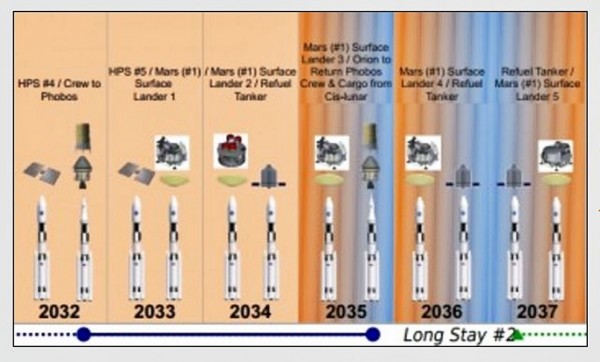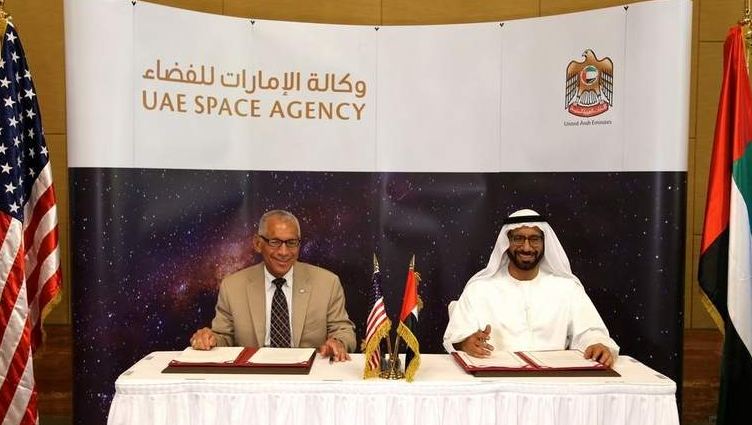US Congress Advisory Body Faults NASA for Slow Pace of Mars Landing Program
| Arthur Dominic Villasanta | | Jun 24, 2016 08:28 AM EDT |
(Photo : NASA) NASA's Mars Plan
Under pressure from an impatient U.S. Congress, NASA is fleshing out its final plan for Mars missions that will eventually see NASA's first astronauts land on the Red Planet by 2035. SpaceX, however, intends to accomplish this feat by 2015, or 10 years earlier.
NASA reported it continues to work towards a 2018 debut for the Space Launch System (SLS) launch with the Exploration Mission -1 (EM-1) Orion spacecraft. SLS will eventually take NASA astronauts to Mars by 2035.
Like Us on Facebook
The next Orion mission, this time with a crew, is set for "no later than" 2023. NASA, however, hopes to attain this target earlier to avoid a five year gap between its first two SLS missions.
NASA's Aerospace Safety Advisory Panel (ASAP) was briefed on the status of the agency's Mars planning by Bill Hill, Deputy Associate Administrator for Exploration Systems Development (ESD) in NASA's Human Exploration and Operations Mission Directorate.
ASAP evaluates NASA's safety performance and advises the agency on ways to improve that performance. It's a senior advisory committee that reports to NASA and Congress.
Hill said NASA is working towards a three year mission to Mars. He noted NASA managers are "beginning to lay out the framework" on what must be done to learn how astronauts can live, work and remain healthy for a long-duration mission that can take anywhere from five to six months one-way.
ASAP has criticized Orion's apparent inability to fully conduct Mars missions since its heat shield can't survive the increased re-entry velocity when returning to Earth directly from Mars.
Hill said NASA needs to develop a capability where Orion can survive the 13.5 kilometers per second re-entry velocity. He said this problem will be explored in the coming years.
ASAP also said it's been asking NASA for a formal plan "for some time" as to what technologies will be required for the Mars program and when they will be needed.
Hill said NASA is in the beginnings of "putting the meat on the bones" for the "providing ground" phase or the transitional period where NASA turns its attention from the ISS to cislunar space (the space between the Earth and the Moon).
NASA's current plan calls for orbiting a manned space station in cislunar space that will serve as a "pit stop" for future treks to Mars and the asteroid re-direct mission. Congress wants NASA to again land humans on the Moon and to forego its asteroid re-direct mission.
Experts agree it will take a large increase in funding to push NASA towards a viable plan that might lead to speeding-up this timetable. NASA has publicly pinpointed 2035 as the year it intends to land humans on Mars but current funding levels don't support this date.
Hill also pointed out NASA's current plan to get to Mars calls for 41 SLS flights from 2018 through 2046 in the path towards surface missions. NASA intends to land astronauts first on Phobos and later on Mars itself.
TagsU.S. Congress, NASA, Mars, Space Launch System, Aerospace Safety Advisory Panel
©2015 Chinatopix All rights reserved. Do not reproduce without permission
EDITOR'S PICKS
-

Did the Trump administration just announce plans for a trade war with ‘hostile’ China and Russia?
-

US Senate passes Taiwan travel bill slammed by China
-

As Yan Sihong’s family grieves, here are other Chinese students who went missing abroad. Some have never been found
-

Beijing blasts Western critics who ‘smear China’ with the term sharp power
-

China Envoy Seeks to Defuse Tensions With U.S. as a Trade War Brews
-

Singapore's Deputy PM Provides Bitcoin Vote of Confidence Amid China's Blanket Bans
-

China warns investors over risks in overseas virtual currency trading
-

Chinese government most trustworthy: survey
-

Kashima Antlers On Course For Back-To-Back Titles
MOST POPULAR
LATEST NEWS
Zhou Yongkang: China's Former Security Chief Sentenced to Life in Prison

China's former Chief of the Ministry of Public Security, Zhou Yongkang, has been given a life sentence after he was found guilty of abusing his office, bribery and deliberately ... Full Article
TRENDING STORY

China Pork Prices Expected to Stabilize As The Supplies Recover

Elephone P9000 Smartphone is now on Sale on Amazon India

There's a Big Chance Cliffhangers Won't Still Be Resolved When Grey's Anatomy Season 13 Returns

Supreme Court Ruled on Samsung vs Apple Dispute for Patent Infringement

Microsoft Surface Pro 5 Rumors and Release Date: What is the Latest?













